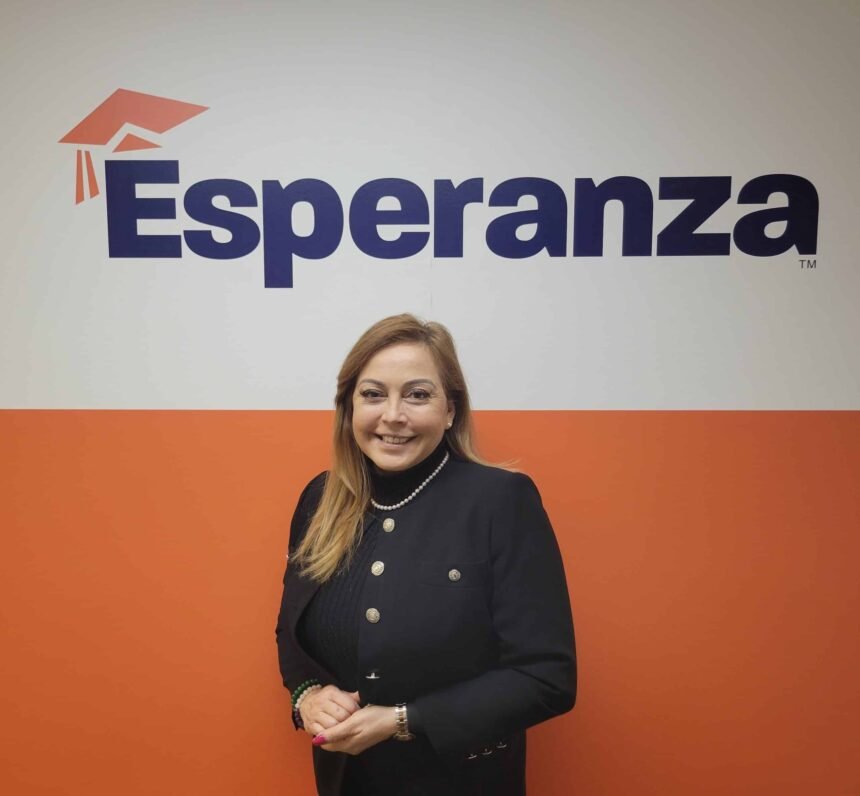Margaret Sanchez, CEO of Esperanza, is on a mission to shape Ohio’s future by empowering students to become productive citizens, one student at a time. She’s unveiling the exciting next steps for this cornerstone Latino organization.
Sanchez steps up as CEO of Esperanza, an organization most known for their tailored educational programming that brings leadership and mentoring to Cleveland’s Latino/a students. Esperanza boasts a 96% high school graduation rate among its youth leadership program participants. As one of the few Cleveland nonprofits offering dual-language opportunities, Esperanza remains committed to student success. The goal is to continue to enshrine Esperanza as a cornerstone of the Latine community in Cleveland.
For 15 years, Victor Ruiz served as CEO of Esperanza. In 2024, he announced his plans to step down. The organization then began its search for a new leader.
Then, on Dec. 17, 2024, Esperanza Inc. announced the appointment of its new CEO, Margaret Sanchez. “The search for a new leader began last December following Victor’s decision to step down after 15 successful years as Esperanza’s President and CEO,” the organization stated. Margaret brings a wealth of experience, having secured millions in funding for nonprofits and demonstrating a strong expertise in development. She previously served as a CEO of the Zambrano Foundation from 2011-2015, where she successfully built a nonprofit from the ground up. Her background also includes marketing, communications, community relations, budget management, and organizational development.
Margaret officially assumed her role on Jan. 6, 2025, with Victor remaining as an advisor through February to ensure a seamless transition.
Margaret sat down with The Land’s Community Journalist Maria Agosto-Vaughan to chat about her experience with immersive fundraising and how this year’s scholarship fundraiser will have a vibrant live experience. Sanchez shares the state of the current programs at Esperanza and her first-year goals for the institution.
MA: Margaret, Esperanza has been a staple in the local Latino community for 40 years. Can you tell us a little about what achievements or favorite projects you worked on during your time with the YWCA?
MS: As vice president of development, I made sure that we told the story. YWCA has been incorporated since 1868, so it is over 150 years old.
In my first two weeks there we designed Empowerment Tours so the entire history of the YWCA of Greater Cleveland was displayed. Through our research we found out that, in the early 1900s, each parent — mother — would have access to childcare, that included food, for 50 cents a day.
We invited funders and friends of the YWCA to join us on these empowerment walks, which showcased the history and showed them how many laws were changed thanks to their advocacy. We were able to show them YWCA’s role in supporting the Voting Rights Act and the (1963) Martin Luther King March on Washington. YWCA was one of the sponsoring organizations that promoted the march.
MA: Margaret shared she plans to incorporate similar immersive experiences into this year’s scholarship luncheon, Fiesta of Hope: Tropigala. Fiesta of Hope funds more than 100 scholarships each year for local Hispanic/Latino students. The Esperanza scholarship is now open to high school seniors until March 15.
Tropigala will be an experiential event celebrating Hispanic culture through music and parrandas. Performers will visit each table, encouraging guests to dance. Attendees will receive maracas and tambourines as part of the festivities. The event will take place on Saturday, Sept. 13, at Hotel Cleveland, 24 Public Square in the Grand Ballroom.
MA: You mentioned you were with the YWCA for a year and a half. Where did you work before that?
MS: Before that, I was at Hispanic Unity of Florida. In Florida, I worked at an organization that was the same age as Esperanza — it was started in 1982, and Esperanza was started in 1983 — both were created to support Hispanics and other members of the community.
Hispanic Unity provided human services. It had an English for Speakers of Other Languages (ESOL) program, a Center for Working Families (workforce development), an after-school program, and a senior program called our Abuelitos Program. We took care of our abuelitos. It was a senior center where they could spend the whole day, so you could go to work with peace of mind. You could drop off your abuelito or abuelita at the center and pick them up at 5 p.m. They received breakfast, lunch, and dinner, as well as assistance and a lot of valuable health information.
MA: How would you describe Esperanza to someone who is unfamiliar with the organization? What programs does Esperanza offer to support students?
MS: When you wear the hat of the President you have to oversee everything, so the first thing I wanted to see was the financials, I wanted to see the administration, I wanted to see where the needs are. Esperanza serves approximately 2,000 students annually, through a range of programs designed to support academic success, social and emotional strength, and learn within the context of their culture.
The Hispanic Youth Leadership Program (HYLP) serves 400 middle and high school students through after-school programming, currently operating in four West Side high schools in Cleveland. The program emphasizes student expression, reflective leadership, community service, life and employment skills, and social-emotional development, preparing students for both academic and personal success.
96% of [Esperanza] program participants graduate high school, and they then have the opportunity to apply for our scholarship. Additionally, 80% have expressed that they feel more confident in their social and emotional skills, which is crucial. Growing up can be challenging, and understanding why certain things happen can be difficult, especially while adapting to a new culture.
MA: How has your transition into this role been? What are some of the most valuable lessons you’ve learned from your time with Mr. Ruiz?
MS: It’s been 2.5 weeks with Victor — it’s total immersion. I have worked in the nonprofit world for 25 years. Once you know how to manage, nonprofits all have the same goals: to improve your community and to care for others. The only thing that changes is the service and the mission, but the impact is still to improve your community and impact lives.
Victor and I have been visiting the schools where we serve. I recently visited Buhrer, and the vice principal said that 85% of Buhrer is Hispanic. So think — 85% of students, their parents, and their families are all contributors to our city. They go shopping and hire services. At Esperanza, we are doing a great job — we are impacting the future of Ohio. If they ask me what the impact is, it’s making productive citizens.
We also visited Natividad Pagán, where the school is 45% Hispanic. In the after-school program, we have other nationalities: Nepali, children from Afghanistan, Haiti — although a majority are Hispanic. I was present when they were teaching a few algebra exercises. It was beautiful because they were all together, actively participating. They talked about heritage and what their culture meant to each of them. I loved it — absolutely.
Victor has introduced me to many of the sponsors for Esperanza, and he’s let me know how loyal the board members are. I was in awe that during the interview phase, I looked at each one of the board members’ social media accounts, and they are announcing the programs and helping us fundraise. You cannot do it alone — they are the stakeholders. So when I saw that, it showed me that someone has our back.
Some of the board members were former clients who started working with Esperanza while they were in school. Now, they have graduated from college with their degree and give back to the organization. Some of the staff members have been at Esperanza for eight or even 13 years — it says a lot. The commitment of the board and staff surprised me and has helped us impact more lives. Talking about it gives me goosebumps.
MA: Does Esperanza track where its students go to college and their graduation rates at those institutions?
In 2016, after years of success with its high school programs, Esperanza expanded its support by launching a comprehensive post-secondary program to help bridge the transition for students entering college. This initiative, 𝐋í𝐝𝐞𝐫𝐞𝐬 𝐀𝐯𝐚𝐧𝐳𝐚𝐧𝐝𝐨 (Líderes), is a required component of the Esperanza scholarship, although students not awarded the scholarship are offered the opportunity to participate.
In 2022, Esperanza received national recognition for this impactful program, and was awarded the 2022 Example of Excelencia for Community-Based Organizations. Líderes offers mentoring, internship search support, and individualized case management.
MS: We make sure they graduate. They get the right mentorship, gain valuable leadership skills, and are exposed to various companies, giving them alternatives for their future. When you graduate, it’s sometimes uncertain where you’ll end up, right? So, they attend in-person events, participate in panels, and hear from speakers. Students in the program engage in job shadowing, financial check-ups, study skills workshops, Líderes y servicio, “taking care of themselves” lessons, and partner-specific workshops.
With a 99% retention rate and a 90% graduation rate, over the last seven years 100% of the students who complete our Líderes program say they feel equipped and prepared for college. They are empowered by a culturally and academically relevant curriculum. Since the program’s launch in 2016, more than 600 students have gone through it.
MA: What are your hopes for the year?
MS: Sustainability is very important to be able to continue with our programs to grow the organization. Victor has done such an amazing job that not only do we want to continue his legacy, but to grow it — and who knows, we may be able to expand our wings to other cities or even to other states. You never know, because the model works, and we have proven that. Esperanza has proven this just by having individuals on the board who started here when they were teenagers. Now, they are professionals, they are executives of big companies, and it shows.
One of my goals this year is to bring all the alumni together. So, if you are an alum of Esperanza programs or scholarships, please contact me at Margaret@esperanzainc.org. We do have alumni who support us, but at the same time — can you imagine? We’re talking about 40 years of impacting and creating a new generation of Americans, giving back to the country. Starting in 1983 to now, one thing I want everybody to know is that we contribute and give back to this culture because we have been welcomed. Our main idea is to turn all these individuals into productive citizens. We all purchase things, we all pay taxes, and we are here in Ohio.
I didn’t have an organization like Esperanza when I came [to the US] in the 1970s, and if I would have had an Esperanza, I probably would have gone farther, earlier. I am also a product of this type of organization.
Another goal is we need to educate people on why voting is so important. It’s a kind of freedom, you know? And you can translate that freedom into having democracy, having a voice, and creating a better world in your city or your country.
So, we need to educate students and people of any nationality — even our very own citizens — to go out there and vote. Get out the vote, yes. When I worked at the National Association of Latino Elected and Appointed Officials, I was in charge of promoting voting for three years in the Latino community in the Tri-County area of South Florida, from West Park to Miami.
So, we created task forces that included legislators, council members, mayors, and members of the private sector who wanted to contribute to their own cities. I would say bringing all the nonprofits together — leaders of nonprofits—so we could disseminate information and let everybody know that voting was important, as was being counted in the U.S. Census. We taught why it was important to vote — as a citizen of your country or your city, these are the benefits: you are helping your city grow, improving schools, and strengthening education.
MA: Esperanza has expanded in the US Bank Building through the years, initially, being on the 4th floor but now having expanded to the classrooms on the second floor as well as the connected learning center on the first. Does Esperanza plan to buy a physical building in the community?
MS: I think it’s a conversation that I’m having with the board for the future. One of my goals is for Esperanza to have its own home, but I also think we need to be ready. It’s not something you achieve overnight. I’ve done capital campaigns before, and they can take 5 to 10 years. But, you know, there are philanthropists out there who may want to contribute. It would be great to have a — well, you know — a big building where we can say, “We’re about education. We need classrooms. We need areas for recreation.” So, it would be amazing to have that opportunity to have our own building, absolutely.
How to learn more about Esperanza
Esperanza awarded 103 scholarships, totaling more than $100,000, last year alone. The Esperanza Scholarship Application is open until March 15th, offering students the opportunity to receive financial support for their education.
There are many ways individuals and organizations can learn more about Esperanza’s mission. Scholarship sponsorship opportunities start at $1,500, with a presenting sponsorship awarded at $40,000. Sponsors can fund named scholarships, allowing them to directly see the impact of their contribution on students’ lives. Those interested can also purchase tickets to this year’s Fiesta of Hope: Tropigala. For more details, contact Margaret Sanchez (Margaret@esperanzainc.org) or Elizabeth Semidei (elizabeths@esperanzainc.org).
Through its Back-to-School Celebration, Esperanza distributes over 2,000 backpacks filled with school supplies—free of charge—to K-12 students in the community, ensuring they start the year equipped for success. There are also sponsorship opportunities, including the chance to host vendor tables or place your materials in the thousands of book bags distributed. Last year’s Back-to-School Giveaway drew over 4,000 attendees.
“This (Esperanza) is a business—the only difference is that instead of buying a yacht, we reinvest in the community. Thanks to generous donors and philanthropists who trust organizations like Esperanza, we can create lasting impact and change lives. The mission may be different [from one non-profit to another], but the goal remains the same—to strengthen our community and transform futures.” Margaret Sanchez, CEO of Esperanza Inc.
Editor’s note: Victor Ruiz is board president for The Land










